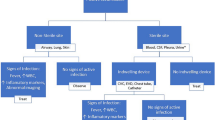Abstract
Objective
To characterize the epidemiology of polymicrobial bacteremia (PMB) among critically ill patients.
Design
Prospective clinical study.
Setting
University medical center.
Patients
All patients with positive blood cultures in a medical-surgical ICU.
Measurements
PMB represents 8.4% of all true bacteremia in our ICU. Most of these patients were post-operative but none had malignancies or significant immunodepression. Over three-quarters of the episodes were nosocomial. No significant differences in factors associated with PMB were found when they were compared with a cohort of 154 monomicrobial episodes. Enterobacteriaceae were the most common organisms. Intravascular devices (42.8%) were the most common source of PMB, followed by intra-abdominal origin (21.4%). The overall mortality was 7.1%, a lower rate than has previously been described.
Conclusions
We suggest catheter replacement in patients who develop PMB and improving techniques of catheter maintenance in order to reduce its incidence.
Similar content being viewed by others
References
Reuben AG, Musher DM, Hamill RJ, Brouke I (1989) Polymicrobial bacteremia: clinical and microbiologic patterns. Rev Infect Dis 11:161–183
Cooper GS, Haulir DS, Shlaes DM, Salata RA (1990) Polymicrobial bacteremia in the late 1980s: predictors of outcome and review of the literature. Medicine (Baltimore) 2:114–123
Gatell JM, Trilla A, Latorre X, Almela M, Mensa J, Moreno A, Miro JM, Martinez JA, Jimenez de Anta MT, Soriano E, Garcia San Miguel J (1988) Nosocomial bacteremia in a large Spanish teaching hospital: analysis of factors influencing prognosis. Rev Infect Dis 10:203–210
Maki DG, Weise CE, Sarafin HW (1977) A semiquantitative culture method for identifying intravenous catheter-related infection. N Engl J Med 296:1305–1309
Lennette EH, Balows A, Hausler WJ, Shadomy HJ (ed) (1985) Manual of clinical microbiology, 4th edn. American Society for Microbiology, Washington DC
Ing AF, McLean PH, Meakins J (1981) Multiple organism bacteremia in the surgical intensive care unit: a sign of intraperitoneal sepsis. Surgery 90:779–886
Kiani D, Quinn EL, Burch KH, Madhaun T, Saravolatz LD, Neblett TR (1979) The increasing importance of polymicrobial bacteremia. JAMA 242:1044–1047
Mackowiak PA, Browne RH, Southern PM, Smith JW (1980) Polymicrobial sepsis: an analysis of 184 cases using log linear models. Am J Med Sci 290:73–80
Roselle GA, Watanakunakorn C (1979) Polymicrobial bacteremia. JAMA 242:2411–2413
Monif GR, Baer H (1976) Polymicrobial bacteremia in obstetric patients. Obstet Gynecol 48:167–169
Dupont HL, Spink WW (1969) Infections due to gram-negative organisms: An analysis of 860 patients with bacteremia at the University of Minnesota Medical Center, 1958–1966. Medicine 48:307–332
Elting LS, Bodey GP, Fainstein V (1986) Polymicrobial septicemia in the cancer patient. Medicine 65:218–225
Hermans PE, Washington JA (1970) Polymicrobial bacteremia. Ann Intern Med 73:387–392
Kreger BE, Craven DE, Carling PC, McCabe WR (1980) Gramnegative bacteremia IV. Reevaluation of clinical features and treatment in 612 patients. Am J Med 68:344–355
Maki DG (1989) Risk factors for nosocomial infection in intensive care. Arch Intern Med 149:30–33
Ponce de Leon S, Critchely S, Wenzel RP (1984) Polymicrobial bloodstream infections related to prolonged vascular catheterization. Crit Care Med 12:856–859
Moyer MA, Edwards LD, Farley L (1983). Comparative culture methods on 101 intravenous catheters: routine, semiquantitative, and blood cultures. Arch Intern Med 143:66–69
Collignon PJ, Soni N, Pearson LY, Woods WP, Munro R, Sorrell TC (1986) Is semiquantitative culture central vein catheter tips useful in the diagnosis of catheter-related bacteremia? J Clin Microbiol 24:532–535
Rello J, Coll P, Prats G (1991) Laboratory diagnosis of catheter-related bacteremia. Scand J Infect Dis 23:583–588
Rello J, Gatell JM, Almirall J, Campistol JM, Gonzalez J, Puig de la Bellacasa J (1989) Evaluation of culture techniques for identification of catheter-related infection in hemodialysis patients. Eur J Clin Microbiol Infect Dis 8:620–622
Cleri DJ, Corrado ML, Seligman SJ (1980) Quantitative culture of intravenous catheters and other intravascular inserts. J Infect Dis 141:781–786
Brun-Buisson C, Abrouk F, Legrand P, Huet Y, Larabi S, Rapin M (1987) Diagnosis of central venous catheter-related sepsis: Critical level of quantitative tip cultures. Arch Intern Med 147:873–877
Boey JH, Way LW (1980) Acute cholangitis. Ann Surg 191:264–270
Shimada K, Naro T, Inamabu T, Urayama K, Adachi K (1981) Bacteriology of acute obstructive cholangitis of the aged. J Clin Microbiol 14:522–526
Siegman-Igra Y, Schwartz D, Konforti N, Perluk C, Rozin RR (1988) Septicemia from biliary tract infection. Arch Surg 123:366–368
Author information
Authors and Affiliations
Rights and permissions
About this article
Cite this article
Rello, J., Quintana, E., Mirelis, B. et al. Polymicrobial bacteremia in critically ill patients. Intensive Care Med 19, 22–25 (1993). https://doi.org/10.1007/BF01709273
Received:
Accepted:
Issue Date:
DOI: https://doi.org/10.1007/BF01709273




